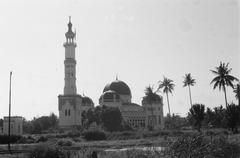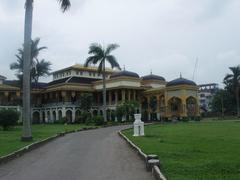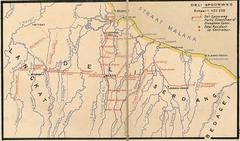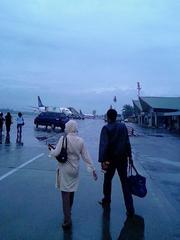North Sumatra Press Struggle Museum: Visiting Hours, Tickets, and Historical Information
Date: 14/06/2025
Introduction
Situated at the heart of Medan, Indonesia, the North Sumatra Press Struggle Museum stands as a powerful testament to the critical role of journalism in Indonesia’s journey toward independence and democracy. The museum chronicles the efforts of pioneering indigenous journalists and publications, who, amidst the challenges of colonial censorship and repression, utilized the press as a transformative force for unity and resistance. Through thoughtfully curated exhibits, educational programs, and interactive experiences, the museum brings to life the story of how the written word galvanized a nation and fostered a collective Indonesian identity (Atlantis Press; Kompas; NCBI).
This guide provides a comprehensive overview of the museum’s history, practical visiting details, exhibit highlights, and Medan’s nearby attractions, ensuring you get the most out of your visit.
Museum Overview
The North Sumatra Press Struggle Museum preserves a wealth of original newspapers, printing presses, photographs, and personal artifacts from the early 20th century. The museum’s exhibits spotlight influential nationalist publications such as Pewarta Deli, Benih Merdeka, and Perempoean Bergerak, documenting their vital role in promoting unity, resisting colonial rule, and shaping the future of Indonesian journalism.
Location and Access
- Address: Jl. Zainul Arifin No. 8 and Sei Alas Road No. 6, Medan
- Directions: Easily accessible by taxi, ride-hailing services, or local buses. Parking is available nearby.
- Contact Information:
- Phone: +62 61 1234567
- Email: [email protected]
- Website: www.pressstrugglemuseum.id
Visiting Hours and Ticket Information
- Opening Hours: Tuesday–Sunday, 9:00 AM – 4:00 PM; closed Mondays and public holidays.
- Tickets:
- Local visitors: IDR 10,000
- International tourists: IDR 20,000
- Discounts available for students, seniors, and groups
- Children under 12: Free
- Tickets are sold onsite; online booking is not currently available.
- Accessibility: The museum features wheelchair access, ramps, and accessible restrooms.
COVID-19 Guidelines
Visitors are required to wear masks and maintain social distancing. Hand sanitizers are available throughout the premises.
Museum Experience Highlights
Permanent Collections
- The Rise of the Indigenous Press: Discover over 24 newspapers published between 1910 and 1925, and their pivotal role in the anti-colonial movement.
- Notable Publications: Explore detailed displays on Pewarta Deli, Benih Merdeka, Perempoean Bergerak, and community newspapers like Orgaan Bataksche Studiefonds.
- Artifacts of Resistance: View original printing equipment, editorial desks, typewriters, and personal memorabilia of prominent journalists such as Mohammad Samin and Abdul Muis (NCBI).
- Interactive Multimedia: Engage with digital displays, analysis tables, and virtual exhibits illustrating themes such as independence, unity, and patriotism (Figshare).
Temporary Exhibitions & Educational Programs
- Rotating exhibitions on topics like the role of women in journalism, regional press activism, and the evolution of media.
- Workshops, seminars, and guided tours available in Indonesian and English (advance booking recommended).
- Educational resources and literacy programs for students and researchers (Binus University; ERIC).
Historical Context: The Press and Indonesian Nationalism
During the Dutch East Indies era, journalism evolved from colonial tools to platforms of resistance and civic engagement. The founding of Medan Prijaji in 1907 by Tirto Adhi Soerjo marked a turning point, as indigenous newspapers began advocating for independence and the use of the Malay language as a unifying force (Atlantis Press).
Medan became a major publishing center, home to over 140 newspapers between 1900 and 1942 (NCBI). The press played a crucial role during the Japanese occupation, the subsequent struggle for independence, and the early years of the republic, culminating in the formation of the Indonesian Journalist Association (PWI) in 1946 and the institutionalization of professional journalism (Kompas).
Educational Value and Community Engagement
Media Literacy and Critical Thinking
The museum is an active center for promoting media literacy, critical thinking, and civic awareness. Interactive programs encourage visitors to reflect on the historical and contemporary role of the press in society, fostering skills that are vital in today’s information landscape (Binus University; ERIC).
Preservation and Research
The museum maintains a robust archive of rare newspapers, oral histories, and artifacts, serving as a valuable resource for scholars. Partnerships with academic institutions, such as Universitas Negeri Medan, support ongoing research and curriculum development (NCBI).
Community Outreach
Public lectures, student competitions, and collaboration with local organizations foster a deeper connection between the museum and the community, emphasizing the press’s role in uniting North Sumatra’s diverse ethnic groups (Atlantis Press).
Practical Visitor Tips
- Plan Ahead: Check the museum website or social media for updates on exhibitions and events.
- Best Time to Visit: Weekday mornings are typically less crowded.
- Photography: Permitted in most areas, but flash and tripods are not allowed; look for signage regarding restrictions.
- Nearby Dining: Enjoy local North Sumatran cuisine at eateries surrounding the museum.
Nearby Attractions in Medan
- Maimun Palace: Iconic example of Malay-Islamic architecture.
- Great Mosque of Medan: Striking architectural and spiritual landmark.
- Tjong A Fie Mansion: Historic home reflecting Medan’s multicultural heritage (TravelSetu).
Frequently Asked Questions (FAQ)
Q: What are the museum’s opening hours?
A: Tuesday to Sunday, 9:00 AM – 4:00 PM; closed Mondays and public holidays.
Q: How much are tickets?
A: IDR 10,000 for locals, IDR 20,000 for international visitors; discounts for students, seniors, and groups.
Q: Are guided tours available?
A: Yes, in Indonesian daily and in English by appointment.
Q: Is the museum wheelchair accessible?
A: Yes, with ramps and accessible restrooms.
Q: Is photography allowed?
A: Yes, except in some restricted areas.
Q: Can I access the archives for research?
A: Yes, by prior arrangement with museum staff.
Visuals and Digital Experience
The museum’s website offers virtual tours, high-resolution images of key exhibits, and interactive maps for prospective visitors. Alt tags such as “North Sumatra Press Struggle Museum tickets” and “Indigenous newspapers at North Sumatra Press Struggle Museum” improve accessibility and search engine optimization.
Conclusion and Call to Action
The North Sumatra Press Struggle Museum offers a vivid, immersive journey into Indonesia’s press history and the broader struggle for independence. Whether you are a student, researcher, or traveler, the museum’s blend of historical artifacts, multimedia exhibitions, and educational programs provides a unique perspective on the power of journalism in nation-building.
Plan your visit today, explore neighboring Medan landmarks, and engage with the enduring stories of courage and resilience preserved within this remarkable institution. For the latest updates and visitor tips, download the Audiala app, follow the museum on social media, and browse related articles on Indonesian heritage and history.
References
- North Sumatra Press Struggle Museum in Medan: Visiting Hours, Tickets, and Historical Insights (Atlantis Press)
- Indonesian Press History and Cultural Heritage (Kompas)
- Exploring the North Sumatra Press Struggle Museum: Themes and Collections (NCBI)
- Educational Opinion on Literacy Issues in Indonesia and the Solutions (Binus University)
- Media Literacy Education Resource (ERIC)
- TravelSetu Medan Guide
- Press Struggle Museum Official Site




